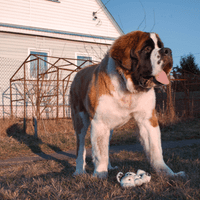Here at Pendleton Veterinary Clinic, we love big mutts and we cannot lie! That includes St. Bernards, of course. May 28th is the official feast day of St. Bernard of Montjoux! As you can probably guess, these gentle giants were named after this Italian monk, who developed the breed. An Anderson, IN veterinarian discusses these amazing pups below.
Passing Score
Who was St. Bernard of Montjoux? He was a patron of hospices at two passes through the western Alps in the 1600’s. These passes are now known as the Great and Little St. Bernard passes. Also in residence at these hospices? The massive dogs we now know and love as St. Bernards.
Rescue Pooches
St. Bernards are renowned for two things: their size and their skill at locating and rescuing lost travelers. (They’re also known for wearing the iconic flasks of booze, which would help warm folks lost in the frigid terrain.)
Long History
Fido first appears in written records in documents from 1707. However, he appears in paintings and drawings that are even older. Two paintings from 1690 by Italian artist Salvator Rosa depict the pups at the monastery.
A True Hero
St. Bernards have saved countless travelers over the past several centuries. However, one of these pooches truly stands out. That would be Barry. (Or perhaps Berry: no one is sure of the spelling.) This very good boy rescued between 40 and 100 people! He became so renowned that there’s a monument to him in the dog cemetery Cimetiere des Chiens. His remains are preserved at a museum in Bern.
Another Very Good Boy
Barry isn’t the only famous St. Bernard. We can’t forget about Rutor, another extraordinary pooch. He was the companion of a priest named Pierre Chanoux. We hope that both Barry and Rutor got lots of yummy treats and belly rubs!
Close Call
The St. Bernard came precariously close to extinction. From 1816 to 1818, severe winters led to an increase in avalanches. Sadly, St. Bernards lost their lives in those years. The remaining ones were bred with Newfoundlands. This led to a marked change in Fido’s appearance … and put a damper on his rescue heroics. The new St. Bernards had different fur, which was heavy and prone to freezing. They still make wonderful pets, though!
Do you have questions about St. Bernards? Contact us, your Anderson, IN animal clinic!









